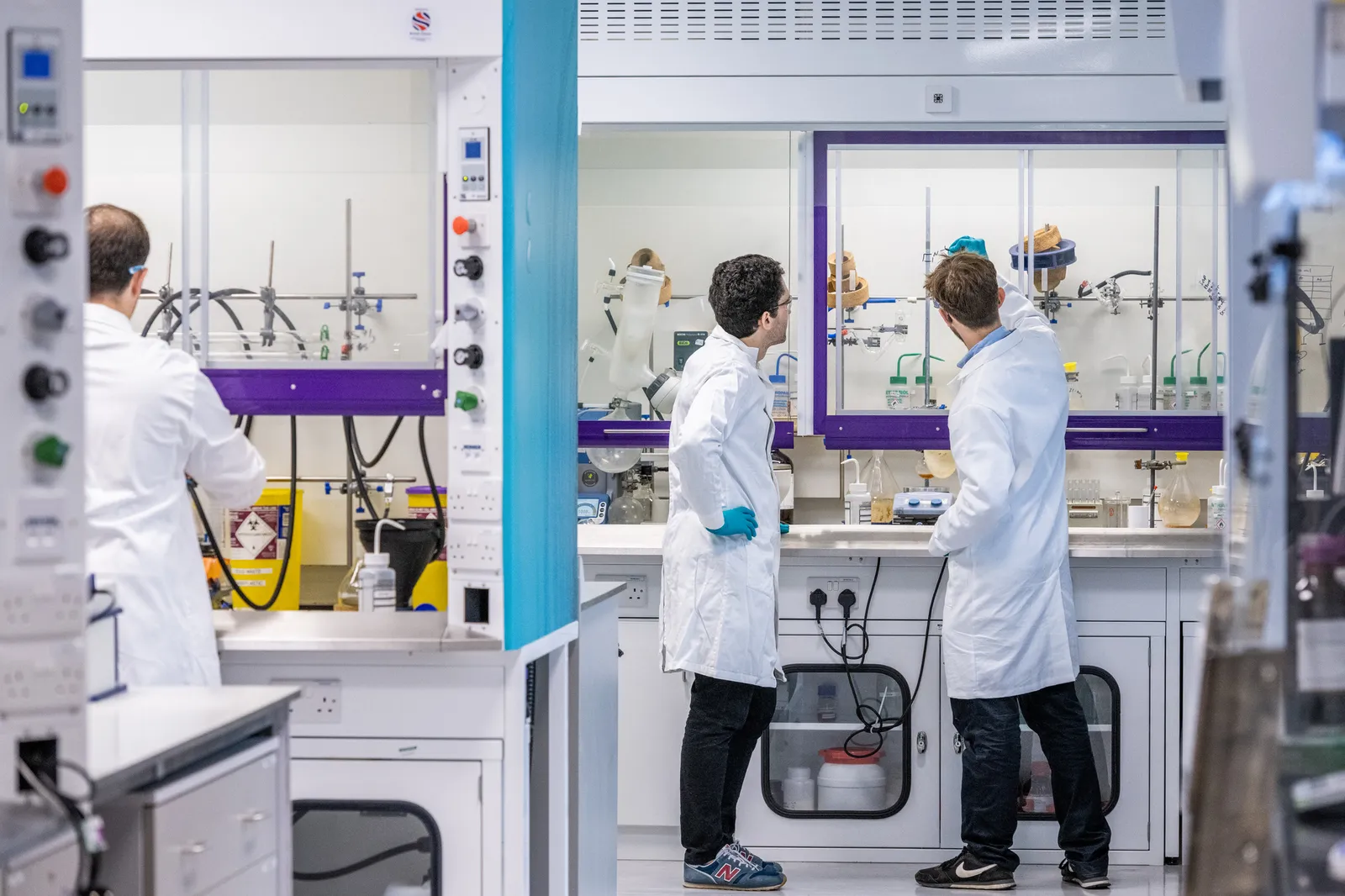Vertex Pharmaceuticals is having a moment. Several moments, in fact.

Months after winning the first-ever approval of a CRISPR-based gene-editing therapy, the company is on the cusp of an FDA decision for the clinically promising non-opioid pain medicine suzetrigine that analysts believe could become a blockbuster — two milestones that demonstrate an R&D-heavy strategy is showing real results.
And all along, Vertex has kept its bread-and-butter cystic fibrosis franchise going strong, as its newest triple-combination drug candidate bested the company’s own blockbuster Trikafta in clinical trials earlier this year. With earlier-stage programs in kidney disease and diabetes, a focused R&D effort underlies what, from the outside, looks like a wide range of disparate targets.
Vertex chief scientific officer Dr. David Altshuler attributes the company’s rarified success to a few pivotal decisions that solidified a strategy emphasizing “targeted conviction” in a biologically proven pipeline.
Vertex stands with only a few companies that have made “serial innovation” a winning model, according to Altshuler. Of about a thousand biotech IPOs since the 1980s, only around 100 have discovered a novel drug and then taken it all the way to launch, he said. And about a quarter of these biotechs have done it twice. Among those, only five companies have done it five times: Genentech, Amgen, Regeneron, Gilead Sciences and Vertex.
Altshuler, a physician and human geneticist who worked with the Human Genome Project and helped found the Broad Institute, where he was deputy director and chief academic officer, has long been convinced that advances in genetic understanding could lead to a revolution in medicine — but before joining Vertex, the industry wasn’t ready to jump in the deep end yet.
“If you look at medicines that are actually transformative, often they’re rooted in human biology, and so we decided we would only work on projects where the human causal biology was clear.”

Dr. David Altshuler
Chief scientific officer, Vertex Pharmaceuticals
“By 2015, [when I came on as chief scientific officer] thousands and thousands of genetic contributors to disease had been found, and I believed some of them were useful drug targets, but no one in the industry was interested,” Altshuler said. “I would consult with biopharma companies, and they would say it was interesting, but no one would work on them because they didn’t have mouse models — there was a risk aversion.”
Altshuler found a home at Vertex, where he said risk isn’t avoided, but is confronted with scientific conviction.
Fateful decisions
Vertex took a circuitous route to its current place among biopharma success stories. The company encountered one of the most influential forks in the road in 2012, after its relatively new hepatitis C drug Incivek began facing a slew of competitors that appeared likely to overtake it in the clinic. Even though Incivek, after less than a year on the market, was “the fastest billion-dollar launch in history” and brought the company to profitability, Altshuler said, its future was in jeopardy as new treatments threatened to “out-innovate” Vertex.
That was when then-CEO Jeffrey Leiden brought Vertex leadership together — including Altshuler, who wasn’t employed there at the time but served on the board of directors — to decide the company’s future. It was the moment Vertex made cystic fibrosis the main focus, betting its drug Kalydeco, approved in 2012 just before Leiden stepped into the role, would launch a franchise that could change how the disease was treated.
“That year, we defined the R&D strategy that we now have, which is very simple: If you’re going to invest disproportionately in R&D, and you’re only going to work on serious diseases for specialty markets, you have to succeed at R&D,” Altshuler said.
To this day, Vertex has one of the highest research ratios of investment in the industry with more than 70% of operating expenses dedicated to drug R&D. The company spent $3.7 billion on R&D in 2023.

In the ensuing years after Kalydeco entered the market, two-drug combinations, including the medications Orkambi and Symdeko, won FDA approval, followed by the three-drug combo Trikafta in 2019, securing Vertex’s spot as one of the best-performing biopharmas in the world. Trikafta brought in $8.9 billion in sales in 2023.And while Vertex’s success in cystic fibrosis kept revenues high, Altshuler and his fellow scientists in the leadership circle — like Leiden and COO Stuart Arbuckle — saw the potential to use that all-in strategy to build an even stronger pipeline to tackle difficult diseases.
“A lot of the people who came here in that period did so not because it was safe and proven, but because it was an opportunity to build something the industry has almost never seen, which is a company that can serially innovate,” Altshuler said.
The Vertex model
Leiden retired from the CEO role in 2020 and was succeeded by Dr. Reshma Kewalramani, who now leads Vertex with the kind of conviction Altshuler said has become the company’s brand. Despite a pipeline that contains different drug modalities and disease targets, the overall strategy and approach have remained “incredibly aligned,” Altshuler said.
“We’re not driven by therapeutic areas or platforms — we have a strategy that everyone can understand has to do with the quality of the product and the likelihood of success,” Altshuler said. “That builds commitment … and an understanding of science and medicine is more important than domain expertise.”
The same year Altshuler joined Vertex as chief scientific officer, the company formed a partnership with CRISPR Therapeutics to develop a drug that was, at the time, for an unspecified disease target. The collaboration ultimately yielded Casgevy, approved late last year for sickle cell disease, and shortly thereafter for beta thalassemia.
"If you’re going to invest disproportionately in R&D, and you’re only going to work on serious diseases for specialty markets, you have to succeed at R&D."

Dr. David Altshuler
Chief scientific officer, Vertex Pharmaceuticals
Although Casgevy’s approval was historic as the first-ever CRISPR-based medication, Altshuler looks at it a different way. Instead of emphasizing the technology, Altshuler is focused on treating the disease.
“There’s way too much hype around technology in this industry, like in Silicon Valley, where it’s always the next widget that’s going to change the world,” Altshuler said. “To change the world in medicine is to know a disease and understand how to approach it. CRISPR is a very powerful tool, but once you have a target, there are multiple ways to get there.”
Still, building on the regulatory success of Casgevy, Vertex and CRISPR have “learned a lot about the manufacturing, how to do the trials [and] how to work with regulators,” Altshuler said. And that could lead to more disease targets like Duchenne muscular dystrophy benefitting from the gene editing tool.
The next milestone
When scientists like Altshuler or Vertex head of cystic fibrosis research Fredrick Van Goor have placed so much of their lives on the line to find R&D success, the results can be emotional, Altshuler said.
He recalls when positive late-stage results became available for the cystic fibrosis drug Trikafta in 2017. Van Goor was taking some time off with family on a boat in the Mediterranean Sea, and Altshuler called him to share the news. Altshuler thought the wind had picked up on the water and that Van Goor couldn’t hear him, but in fact, the researcher on the other end of the line who had spent 17 years toiling over the project was weeping.
“You don’t know if you’re going to be able to do it, and then suddenly it’s visible — it’s no longer an abstraction,” Altshuler said. “This was the first project that I thought, ‘Wow, you really can do this.’”
Now, as the company works on its rolling application for suzetrigine, which it plans to complete midway through this year, Vertex is close to its next big milestone — and a potential blockbuster breakthrough in treating acute and neuropathic pain. Developed with confirmed genetic validation in mind, the drug delivered two phase 3 wins early this year. Its development also harkens back to the company’s beginnings in cystic fibrosis. In fact, both programs came from the mind of Dr. Paul Negulescu, who has led Vertex’s San Diego Research Center since 2003.
“Pain feels to me like CF when I first came across Vertex in 2012,” Altshuler said, pointing out that as the genetic target becomes clear, a medication can grow from that knowledge rather than the other way around, which is what can cause programs to stumble.
“Most drugs fail not because they are bad drugs, not because it’s the wrong patient, not because the FDA is tough, but because the target hypothesis is irrelevant to the patient they’re treating,” Altshuler said. “If you look at medicines that are actually transformative, often they’re rooted in human biology, and so we decided we would only work on projects where the human causal biology was clear.”
With a strategic focus on disease biology, Vertex had to be open to multiple modalities, Altshuler said.
“The hypothesis was that if you focus on targets with clear causal human biology, not symptomatic or reactive, and you used whatever the right tool was, you could succeed in R&D at a higher rate,” Altshuler said.
















